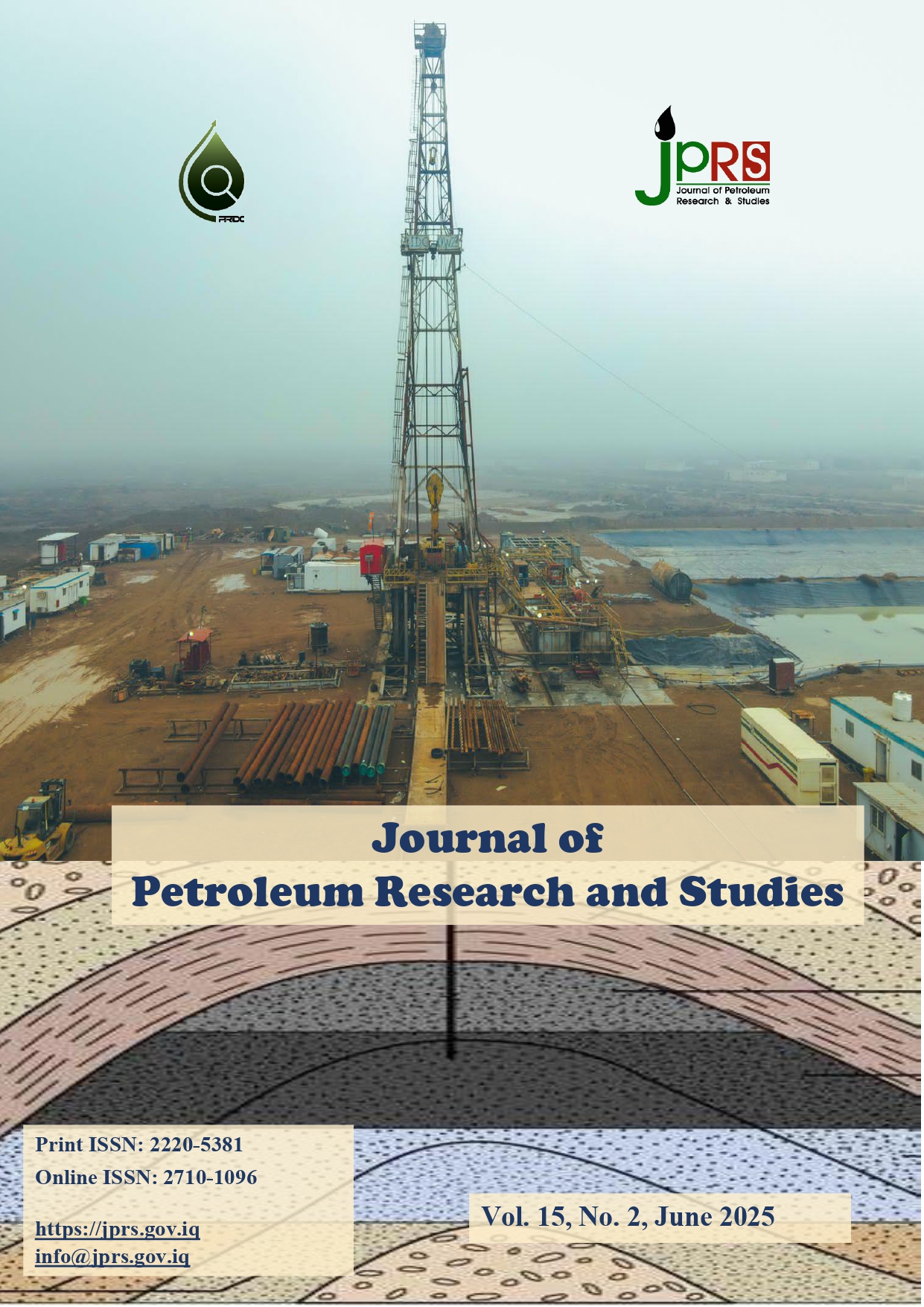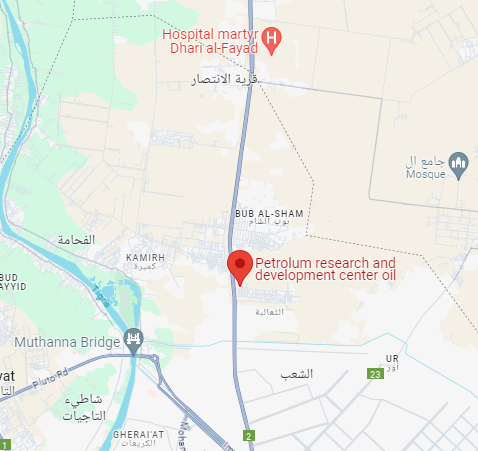التقديرالقائم على الذكاء الاصطناعي لنسبة بواسون لتكوينات الكربونات بأستخدام معاملات الحفر في حقل نفطي بجنوب العراق
DOI:
https://doi.org/10.52716/jprs.v15i2.1072الملخص
عدم استقرار البئر هو مشكلة كبيرة تواجهها عمليات الحفر. وتعتبر الخصائص الميكانيكية للتكوين من بين العوامل العديدة التي تؤثر على عدم استقرار البئر. وتعتبر نسبة بواسون واحدة من هذه الخصائص الميكانيكية وهي عامل رئيسي في النمذجة الميكانيكية للأرض .(GEM) وهي مهمة للغاية لتقليل المخاطر في عمليات الحفر والإنتاج مثل إنتاج الرمال والانهيار والثقوب الضيقة وتوقف الأنابيب. ويساهم تقدير نسبة بواسون في تحسين استرداد الهيدروكربون واتخاذ خيارات مهمة لخطة تطوير الحقل المناسبة. ويمكن تقدير نسبة بواسون (υ) بشكل ساكن وديناميكي. وتقيس التقنيات الساكنة الخصائص في المختبر، ورغم أن التقنيات الساكنة تعتبر الطريقة الأكثر دقة لتحديد نسبة بواسون، إلا أنها مكلفة وتستغرق وقتًا طويلاً وغير قادرة على إنتاج قياسات مستمرة لنسبة بواسون مع عمق البئر. وفي الوقت نفسه، تحسب الطرق الديناميكية الخصائص الديناميكية من مجسات البئر، مثل الكثافة وسرعات الموجات الانضغاطية والقصية، والتي لا تتوفر دائمًا. لذلك في هذه الدراسة تم تطويرموديل للذكاء الاصطناعي (AI) لتقدير نسبة بواسون لتكوين الكربونات في حقل النفط جنوب العراق باستخدام البيانات المتاحة أثناء الحفر. تتألف مجموعة البيانات المستخدمة في هذه الدراسة من أكثر من 451 نقطة، تتراوح من عمق 2228 إلى 2453 مترًا لعمليات التدريب والاختبار. تتضمن هذه البيانات الوزن على الدقاقة (WOB)، وسرعة الدوران (RPM)، ومعدل تدفق الطين (FLW)، وعزم الدوران (T)، وضغط الأنبوب (SPP)، ومعدل الاختراق .(ROP) تشير النتائج إلى أن النموذج الجديد يمكنه التنبؤ بنسبة بواسون بدرجة عالية من الدقة (أي معاملات ارتباط 93%). يتيح التنبؤ بنسبة بواسون للصخور من بيانات الحفر البناء المبكر للموديل الجيوميكانيكي ويوفر التكلفة والوقت مقارنة بالقياسات المختبرية.
المراجع
References
M. Mohiuddin, K. Khan, A. Abdulraheem, and A. Al-Majed, “Analysis of wellbore instability in vertical, directional, and horizontal wells using field data”, J. Pet. Sci. Eng., vol. 55, no. 1-2, pp. 83–92, 2007. https://doi.org/10.1016/j.petrol.2006.04.021.
T. M. Al-Bazali, J. Zhang, C. Wolfe, M. E. Chenevert, and M. M. Sharma, “Wellbore instability of directional wells in laminated and naturally fractured shales”, J. Porous Media, vol. 12, no. 2, pp. 119-130, 2009. https://doi.org/10.1615/JPorMedia.v12.i2.20.
N. W. Tschoegl, W. G. Knauss, and I. Emri, “Poisson’s ratio in linear viscoelasticity – A critical review”, Mechanics of Time-Dependent Materials, vol. 6, pp. 3–51, 2002. https://doi.org/10.1023/A:1014411503170.
M. E. Zeynali, “Mechanical and physico-chemical aspects of wellbore stability during drilling operations”, Journal of Petroleum Science and Engineering, vol. 82-83, pp. 120–124, 2012. https://doi.org/10.1016/j.petrol.2012.01.006
M. Aslannezhad, A. Keshavarz, and A. Kalantariasl, “Evaluation of mechanical, chemical, and thermal effects on wellbore stability using different rock failure criteria”, Journal of Natural Gas Science and Engineering, vol. 78, p. 103276, 2020. https://doi.org/10.1016/j.jngse.2020.103276.
V. Maury, “Rock failure mechanisms identification: A key for wellbore stability and reservoir behaviour problem”, presented at the SPE/ISRM Rock Mechanics in Petroleum Engineering, p. SPE-28049-MS, 1994. https://doi.org/10.2118/28049-MS.
C. J. Nmegbu and L. V. Ohazuruike, “Wellbore instability in oil well drilling: A review”, International Journal of Engineering Research and Development, vol. 10, no. 5, pp. 11–20, 2014.
S. V. Dmitriev, T. Shigenari, and K. Abe, “Poisson ratio beyond the limits of the elasticity theory,” Journal of the Physical Society of Japan, vol. 70, no. 5, pp. 1431–1432, 2001. https://doi.org/10.1143/jpsj.70.1431.
L. E. Malvern, “Introduction to the Mechanics of a Continuous Medium”, Paper No. Monograph, 1969.
K. K. Phani, “Correlation between ultrasonic shear wave velocity and Poisson’s ratio for isotropic porous materials”, Journal of materials science, vol. 43, pp. 316–323, 2008. https://doi.org/10.1007/s10853-007-2055-2
J. Kumar, “The effect of Poisson's ratio on rock properties”, presented at the SPE Annual Fall Technical Conference and Exhibition, p. SPE-6094-MS, 1976. https://doi.org/10.2118/6094-MS.
G. N. Greaves, A. L. Greer, R. S. Lakes, and T. Rouxel, “Poisson’s ratio and modern materials,” Nature Materials, vol. 10, pp. 823–837, 2011. https://doi.org/10.1038/nmat3134.
R. D. Barree, J. V. Gilbert, and M. Conway, “Stress and rock property profiling for unconventional reservoir stimulation”, presented at the SPE Hydraul. Fract. Tech. Conf., 2009. SPE-118703-MS. https://doi.org/10.2118/118703-MS.
M. Ciccotti and F. Mulargia, “Differences between static and dynamic elastic moduli of a typical seismogenic rock”, Geophysical Journal International, vol. 157, no. 1, pp. 474–477, 2004. https://doi.org/10.1111/j.1365-246X.2004.02213.x.
Z. Wang and A. Nur, “Dynamic versus static elastic properties of reservoir rocks”, Seismic and acoustic velocities in reservoir rocks, vol. 3, pp. 531–539, 2000.
A. Abdulraheem, “Prediction of Poisson’s ratio for carbonate rocks using ANN and fuzzy logic type-2 approaches,” presented at the international petroleum technology conference, p. IPTC-19365-MS, 2019. https://doi.org/10.2523/IPTC-19365-MS.
B. D. Al-Anazi, M. T. Al-Garni, T. Muffareh, and I. Al-Mushigeh, “Prediction of Poisson’s ratio and Young’s modulus for hydrocarbon reservoirs using alternating conditional expectation algorithm”, presented at the SPE Middle East Oil and Gas Show and Conf., Manama, Bahrain, p. SPE-138841-MS, 2011. https://doi.org/10.2118/138841-MS.
S. M. Elkatatny, Z. Tariq, M. A. Mahmoud, Z. A. Abdulraheem Abdelwahab, M. Woldeamanuel, and I. M. Mohamed, “An artificial intelligent approach to predict static Poisson’s ratio”, presented at the ARMA US Rock Mechanics/Geomechanics Symposium, Paper Number: ARMA-2017-0771, USA, June 2017.
Z. Tariq, A. Abdulraheem, M. Mahmoud, and A. Ahmed, “A rigorous data-driven approach to predict Poisson’s ratio of carbonate rocks using a functional network”, Petrophysics, vol. 59, no. 6, pp. 761–777, 2018. https://doi.org/10.30632/PJV59N6-2018a2.
C. Chang, M. D. Zoback, and A. Khaksar, “Empirical relations between rock strength and physical properties in sedimentary rocks”, Journal of Petroleum Science and Engineering, vol. 51, no. 3-4, pp. 223–237, 2006. https://doi.org/10.1016/j.petrol.2006.01.003.
O. Siddig, A. F. Ibrahim, and S. Elkatatny, “Estimation of rocks’ failure parameters from drilling data by using artificial neural network”, Scientific Reports, vol. 13, p. 3146, 2023. https://doi.org/10.1038/s41598-023-30092-2.
D. L. Cantrell, R. A. Shah, J. Ou, C. Xu, C. Phillips, X. L. Li, and T. M. Hu, “Depositional and diagenetic controls on reservoir quality: Example from the Upper Cretaceous Mishrif Formation of Iraq”, Marine and Petroleum Geology, vol. 118, p. 104415, 2020. https://doi.org/10.1016/j.marpetgeo.2020.104415.
E. W. Adams, C. Grélaud, M. Pal, A. É. Csoma, O. S. Al Ja'aidi, and R. A. Hinai, “Improving reservoir models of Cretaceous carbonates with digital outcrop modelling (Jabal Madmar, Oman): Static modelling and simulating clinoforms”, Petroleum Geoscience, vol. 17, no. 3, 2011. https://doi.org/10.1144/1354-079310-031.
S. Iraji et al., “Laboratory and numerical examination of oil recovery in Brazilian pre-salt analogues based on CT images,” presented at the 3rd EAGE Conference on Pre Salt Reservoirs, 2022.
H. Al-Khersan, “Depositional environments and geological history of the Mishrif Formation in Southern Iraq”, Proceeding at 4th Arab Petroleum Congress, Dubai, 1975.
A. Aqrawi, G. Thehni, G. Sherwani, and B. Kareem, “Mid-Cretaceous rudist-bearing carbonates of the Mishrif Formation: An important reservoir sequence in the Mesopotamian Basin, Iraq”, Journal of petroleum Geology, vol. 21, no. 1, pp. 57–82, 1998. https://doi.org/10.1111/j.1747-5457.1998.tb00646.x.
Z. Huang, J. Shimeld, M. Williamson, and J. Katsube, “Permeability prediction with artificial neural network modeling in the Venture Gas Field, Offshore Eastern Canada”, Geophysics, vol. 61, no. 2, pp. 422–436, 1996. https://doi.org/10.1190/1.1443970.
A. A. Del Castillo, E. Santoyo, and O. García-Valladares, “A new void fraction correlation inferred from artificial neural networks for modeling two-phase flows in geothermal wells”, Computers & Geosciences, vol. 41, pp. 25–39, 2012. https://doi.org/10.1016/j.cageo.2011.08.001.
E. A. Al-Khdheeawi and D. S. Mahdi, “Apparent viscosity prediction of water-based muds using empirical correlation and an artificial neural network”, Energies, vol. 12, no. 16, p. 3067, 2019. https://doi.org/10.3390/en12163067.
A. Abdulraheem, M. Ahmed, A. Vantala, and T. Parvez, “Prediction of rock mechanical parameters for hydrocarbon reservoirs using different artificial intelligence techniques”, presented at the SPE Kingdom of Saudi Arabia Annual Technical Symposium and Exhibition, p. SPE-126055-MS, 2009. https://doi.org/10.2118/126094-MS.
D. S. Mahdi and E. A. Al-Khdheeawi, “A new model for optimizing drilling variables and penetration rate”, AIP Conference Proceedings, vol. 2443, no. 1, AIP Publishing, 2022. https://doi.org/10.1063/5.0091936.
P. Panja, J. Goral, M. Deo, and J. McLennan, “Prediction of geomechanical properties from elemental analysis using machine learning algorithm”, presented at the 54th U.S. Rock Mechanics/ Geomechanics Symposium, 2020.
D. S. Mahdi, “Predicting drilling rate of penetration using artificial neural networks”, IOP conference series: Materials science and engineering, vol. 1067, p. 012150, 2021. https://doi.org/10.1088/1757-899X/1067/1/012150.
A. S. Eesa and W. K. Arabo, “A normalization methods for backpropagation: A comparative study”, Science Journal of University of Zakho, vol. 5, no. 4, pp. 319–323, 2017. https://doi.org/10.25271/2017.5.4.381.
التنزيلات
منشور
كيفية الاقتباس
إصدار
القسم
الرخصة
الحقوق الفكرية (c) 2025 Doaa S. Mahdi, Emad A. Al-Khdheeawi, Yujie Yuan

هذا العمل مرخص بموجب Creative Commons Attribution 4.0 International License.














